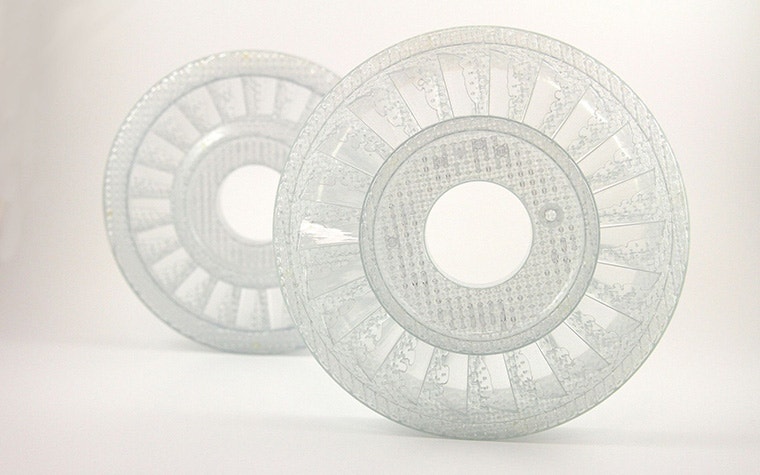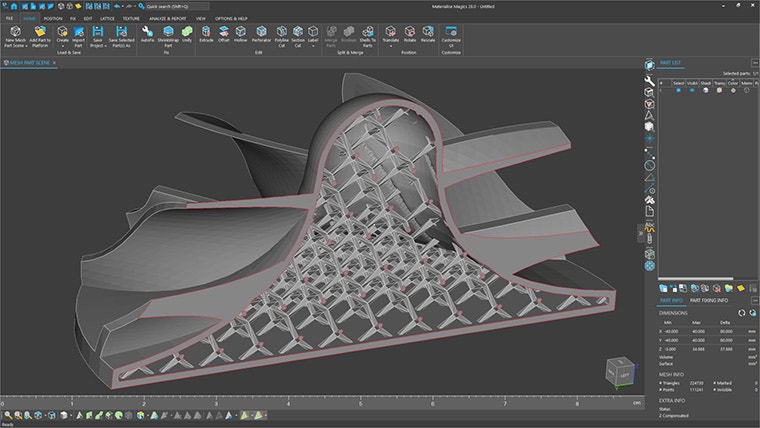EXPERT INSIGHT
How Resin 3D Printing Is Modernizing Investment Casting — A 5,000-Year-Old Manufacturing Process

Investment casting is a manufacturing process that has been around since the Bronze Age. In ancient civilizations, the technique was used to produce anything from basic jewelry to tools.1 Now, various industries are using it for more sophisticated applications, and companies are creating molds of greater complexity with better efficiency, repeatability, and lower costs compared to other casting methods. But how is this possible? Due to the design flexibility of resin 3D printing and additive manufacturing (AM) software, such as the Tetrahedron Slice feature in Materialise Magics’ Lattice module.
Investment casting is an industrial manufacturing process that dates back to around 4,000 BC, with the technique being used in different forms for the last 5,000 years.2 It’s also known as lost-wax casting, one of the oldest metal-forming techniques used throughout history — and the process is still in use today. The investment casting market was valued at $16.55 billion in 2022, with an expected compounded annual growth rate of 5% from 2023 to 2030.3 This form of precision casting is ideal for making complex, high-quality components, and many industries — from aerospace and automotive to medtech and industrial goods — use it. However, the process can be expensive compared to other manufacturing techniques, and there’s little room for error. Traditional molds for pattern creation can cost thousands of dollars with an average lead time of around two months.
As a result, many businesses are looking at other options to improve efficiency and time-to-market, with 3D printing being the obvious choice. AM is a quick, accurate, and cost-effective alternative, and various companies are now consulting with 3D printer original equipment manufacturers (OEMs) to create higher-performant molds that improve production quality. But what are some drawbacks of conventional investment casting, and how can AM solve these issues?
Why choose AM for investment casting?
Investment casting enables you to make complex metal objects and shapes. First, a sacrificial pattern is created (typically out of wax, clay, resin, or another malleable material), and coated in ceramic to make a mold. Once the shell has hardened and fully cured, the material inside is melted and drained, leaving a hollow ceramic mold cavity.
The shell is preheated to remove any remaining moisture to ensure structural integration before it's placed into a casting flask where molten metal is poured into mold’s cavity and allowed to cool. After this is finished, the outer ceramic shell is removed, revealing the fully formed metal part. Finally, inspection and quality control procedures are carried out.
While the process is effective, there are some issues that must be considered.

The five challenges associated with traditional investment casting
- Lengthy tooling and lead times: traditional investment casting is time-consuming due to the creation of complex molds and the need for multiple production steps. Also, the timeline for production tools can be extensive, delaying production cycles and the release of new products’ time-to-market.
- Design limitations: mold-making and pattern removal can be restrictive when using traditional investment casting techniques. Plus, intricate geometries and delicate internal features can be difficult to achieve using conventional methods, while drainage limitations can hinder a part's design freedom and complexity.
- High production costs: tooling, material wastage, and manual, labor-intensive processes can be particularly high with traditional investment casting. This is exacerbated if molds must be redesigned or mistakes occur.
- Lacking an iterative design process: modifying tools or new molds can be cumbersome, time-consuming, and costly. Conventional investment casting isn’t compatible with rapid design iterations, which can affect flexibility and the opportunity to pivot on a design based on user requirements.
- Insufficient economies of scale: it’s difficult to produce small samples or production quantities due to the cost, so minimum order quantities are not a viable option. At the same time, shifting customer demands can make the traditional investment casting process even more strenuous.
Such challenges are mitigated using 3D printing with vat polymerization processes, which include technologies such as stereolithography (SLA), digital light processing (DLP), liquid crystal display (LCD), and hybrid photosynthesis (HPS) — and all of them are excellent options. 3D printing offers design flexibility and the ability to create complicated shapes and geometries with elaborate internal features that are difficult to replicate with other wax fabrication procedures. They can produce extremely detailed, high-resolution wax patterns, making them suitable for investment casting. This makes 3D printing ideal for large, complex, and advanced texturized casting.
It's also easier to refine casting patterns and iterate with 3D printing, as gating configurations and fill orientations can be adjusted quickly to meet ever-changing demands. Plus, dimensions can be adjusted swiftly and accurately with AM, lowering waste and reducing overall shrinkage. Moreover, antimony-free materials lower ash burnout, making it possible for industries like aerospace to use specialty alloys for their more demanding applications.
Finally, AM allows for rapid prototyping and quicker production of wax patterns. Faster design iterations save time, reduce costs, and accelerate time-to-market. In addition, wax patterns can be printed directly, so there’s no need to start specific tooling production and unnecessarily increase costs.
These benefits show how 3D printing is now the preferred option for investment casting, especially for the dental, jewelry, automotive, aerospace, and industrial sectors. However, how does AM integrate into the investment casting workflow, and why is the Tetrahedron Slice feature, formerly known as the Magics TetraShell module, the tried and tested software solution to carry out modern-day investment casting?


How tetrahedron lattices within the Magics Lattice module are used in investment casting for SLA and DLP structures
3D printing can integrate into the pattern creation stage of the investment casting workflow, enhancing the process in multiple ways. First, AM is excellent for pattern creation, as 3D printing can be used to produce wax-like or resin-based patterns. These patterns can be formed rapidly and precisely, no matter the pattern’s complexity. The qualities mentioned above set 3D printing apart from manual wax carving or CNC milling, as both can be laborious, expensive methods. Consequently, custom patterns used for low-volume parts are the key beneficiary of AM. Another advantage of using 3D printing for investment casting is that the process can be streamlined using AM software.
The Tetrahedron Slice feature is part of the Materialise Magics Lattice module, a tool in our flagship data and build preparation software — and the AM industry’s leading software solution for over 30 years. The Lattice module optimizes investment casting resin printing workflows by enabling you to add tetrahedron lattices to patterns, stabilizing parts, and ensuring they’re secure in any direction (in an isotropic way) while delivering adequate material drainage. This is essential because hollow patterns using vat polymerization require resin drainage to maintain adequate structural integrity.
Furthermore, Magics is an open, machine-agnostic software solution that slots into existing systems and workflows to simplify the investment casting process. AM companies have been using the Tetrahedron Slice feature (previously the Magics TetraShell module) for decades to increase the efficiency, repeatability, and quality of their investment casting production. Along with them being compatible with different 3D printers and trusted by some of the biggest OEMs in the AM industry, these solutions also combine with other tools in our larger software ecosystem, like Materialise e-Stage for Resin and the CO-AM Software Platform, to aid various stages of your AM operations — from pattern design and automating support structures to managing your end-to-end AM workflows.
In conclusion, AM has modernized investment casting, enabling more accurate, repeatable designs quickly and at a fraction of the cost compared to traditional investment casting techniques. This is augmented by vat polymerization processes combined with various 3D printing technologies, which offer significant advantages in terms of greater flexibility and design freedom. And the reliable and well-established Tetrahedron Slice feature in the Magics Lattice module provides lattices that enable structurally sound parts with minimal material wastage. Together, they’ve modernized investment casting, simplifying a complex process. Why not use them in your next project and for the decades to come?
Share on:
You might also like
Never miss a story like this. Get curated content delivered straight to your inbox.
